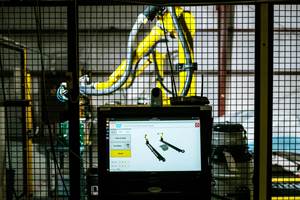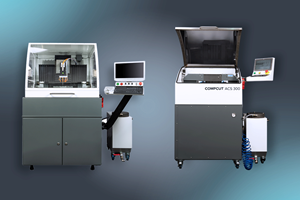"Metalworking" businesses find new niche with composites
Composite structures are replacing machined metal parts in certain applications — most notably, some aircraft components. As this happens, it would be easy to assume that businesses invested in machining metal will see activity decline. From the ground, however, there is plenty of evidence to support a different assumption.
Composite structures are replacing machined metal parts in certain applications — most notably, some aircraft components. As this happens, it would be easy to assume that businesses invested in machining metal will see activity decline. From the ground, however, there is plenty of evidence to support a different assumption.
I possess that view from the ground. I visit all sorts of machining facilities as a writer for Modern Machine Shop, a sister publication to HPC. MMS serves the interests of people who own machining businesses and manage machine shops — facilities with metalworking equipment that includes higher-value machining centers, lathes and grinding machines. However, one of the most expensive metal cutting machine tools at one such facility, Reno Machine Co. (Newington, Conn.), is booked for a solid year to machine parts that are not made of metal. The demand on the machine, these days, is to precisely mill and drill composite parts. Hydrojet also is humming. This midsized machine shop and engineering firm in Reading, Pa., uses both abrasive waterjet machines and metalcutting machining centers to cut and trim composite components. And General Tool (Cincinnati, Ohio), a contract manufacturer accustomed to machining lots of metal parts, currently has three of the company’s 40 or so major metalcutting machine tools given over to machining composite parts. Given the demand the shop is seeing for composites machining, that number will probably increase.
Aircraft components that are made of metal in shops such as these might be cut and bent from rectangular pieces of sheet metal or milled out of solid blocks of aluminum through a process that looks a lot like cutting a detailed sculpture out of a block of stone. However, as HPC readers know, composite structures are made in a fundamentally different way. Machining is a subtractive process, but the composites molding process is additive. The part is layed up — made by building up reinforcement and matrix in layers. One might think a “subtractive” shop would, therefore, have little or no role. Yet there is a critically significant stage of composites manufacturing that is subtractive. The typical demolded composite structure still must be milled or trimmed to size, almost certainly needs holes for fasteners and might also require milled mating surfaces or cut-out ports of particular dimensions and tolerances.
To be sure, the amount of machining is small compared to a typical metal workpiece. The composite structure is very much a near-net-shape part. But by the time the composite component is ready for machining, it already has a lot of cost invested in it. That means that while the volume of material removal is relatively small, the value of the machining is high.
Also, composites behave much differently than metals when they are machined. Metals are homogenous, while composites (by definition) are not. The ingredients in any composite can present contradictory machining de-mands, while any attempt to cut them poses the real and costly danger of delaminating the part. Machine shops need to have the right equipment and skills in place to machine these parts effectively, and many shops are rapidly de-veloping these capabilities.
They also are developing capabilities related to mold tooling. On a recent trip to the U.K., I visited two machine shops that had lost their major sources of revenue when the local automotive industry declined. (Many shops in the U.S. can relate to that.) However, both were tool and die makers, and they found a new market for this expertise in machining and building the steel layup tools for composite aircraft structures.
One of the two, Rojac Tooling Technologies (Wednesbury, West Midlands, U.K.), went a step further. The company expanded into layup of the composite parts on the tooling it builds and purchased an autoclave. Similarly, Hydrojet has machined layup tooling for composites manufacturers for a long time. It, too, plans to acquire an autoclave so it can complete the partial range of services it already provides to composites customers.
In short, many suppliers of machined metal parts are now performing or soon will begin machining activities connected with composites manufacturing. From there, they may develop additional composites-related services. If this work becomes a significant source of business for any of these shops, then metalworking or even machining could consume a smaller portion of the shop’s attention.
But this is not necessarily a radical change. In a way, these metalworking machine shops were never in the “metalworking” business or even the “machining” business. Instead — and all along — they have been in the business of producing high-value parts, according to precise designs and timetables. The high-value parts of the future might require a different mix of capabilities, but the focus and discipline required to consistently meet the customers’ needs will remain unchanged. These capabilities always will be in demand.
Related Content
Top 10 Considerations When Buying a CNC Machine for Composites
For a CNC machine to continue to meet or exceed a company’s needs, it must be built and spec’d with these needs in mind.
Read MoreAI-powered robotic solutions support high-mix manufacturing
AI startup offers automation innovations for high-mix, high-variability, manual surface finishing applications.
Read MoreState-of-the-art composites cutting, machining solutions ensure accuracy, ease of operation
JEC World 2024: Compcut is presenting its advanced composites saw (ACS) and precision composite router (PCR), in addition to inviting attendees to bring their own materials for demonstration purposes.
Read MorePlant tour: Joby Aviation, Marina, Calif., U.S.
As the advanced air mobility market begins to take shape, market leader Joby Aviation works to industrialize composites manufacturing for its first-generation, composites-intensive, all-electric air taxi.
Read MoreRead Next
CW’s 2024 Top Shops survey offers new approach to benchmarking
Respondents that complete the survey by April 30, 2024, have the chance to be recognized as an honoree.
Read MoreFrom the CW Archives: The tale of the thermoplastic cryotank
In 2006, guest columnist Bob Hartunian related the story of his efforts two decades prior, while at McDonnell Douglas, to develop a thermoplastic composite crytank for hydrogen storage. He learned a lot of lessons.
Read MoreComposites end markets: Energy (2024)
Composites are used widely in oil/gas, wind and other renewable energy applications. Despite market challenges, growth potential and innovation for composites continue.
Read More
.jpg;width=70;height=70;mode=crop)

























